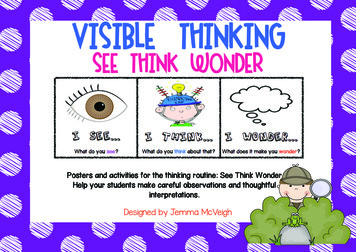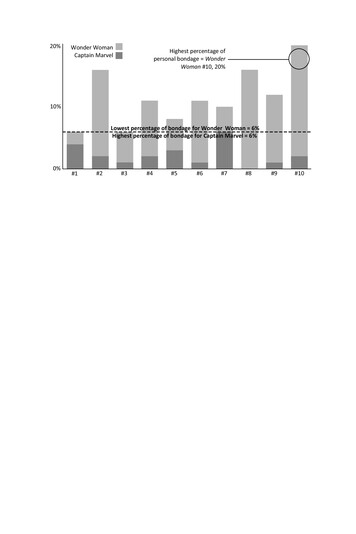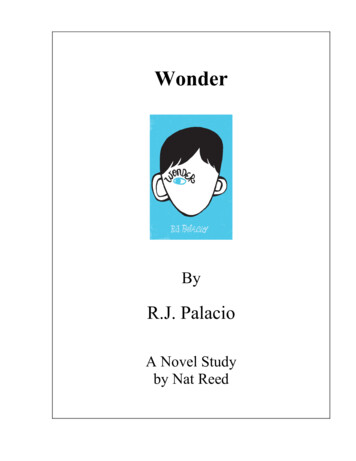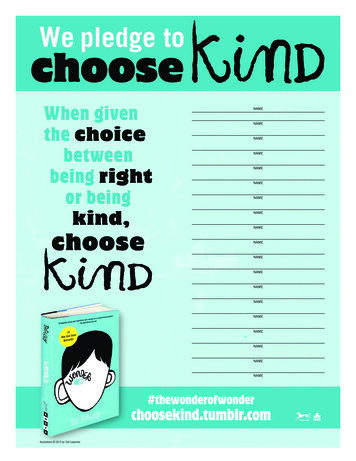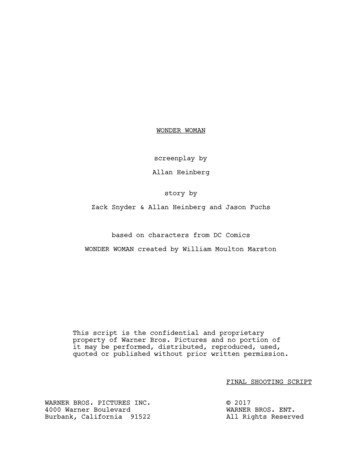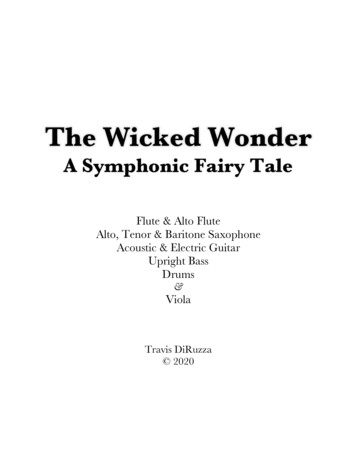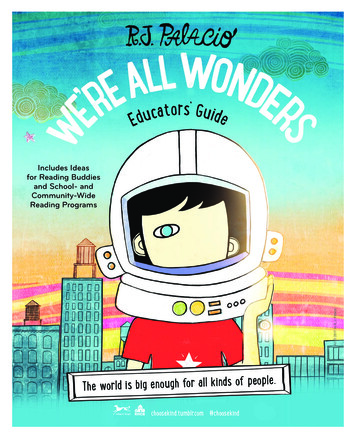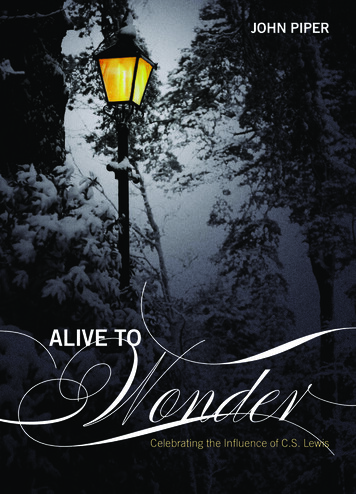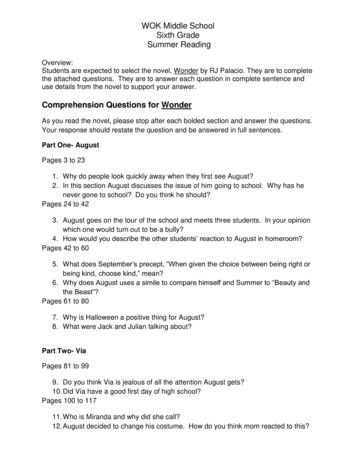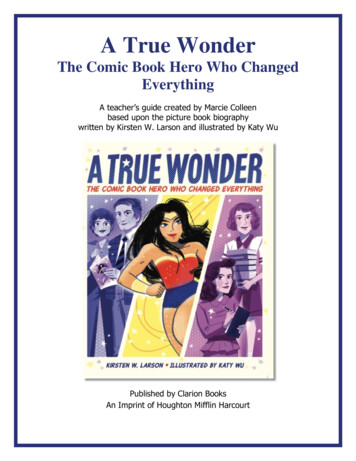
Transcription
A True WonderThe Comic Book Hero Who ChangedEverythingA teacher’s guide created by Marcie Colleenbased upon the picture book biographywritten by Kirsten W. Larson and illustrated by Katy WuPublished by Clarion BooksAn Imprint of Houghton Mifflin Harcourt
Kirsten W. LarsonAuthor, A True Wonder: The Comic Book Hero Who Changed EverythingKirsten W. Larson used to work with rocket scientists at NASA. Nowshe writes books for curious kids. She’s the author of Wood, Wire,Wings: Emma Lilian Todd Invents an Airplane, illustrated by TracySubisak (Calkins Creek, 2020), A True Wonder: The Comic BookHero Who Changed Everything, illustrated by Katy Wu (ClarionBooks, 20210) Cecilia Payne: Making of a Star (Scientist), illustratedby Katherine Roy (Chronicle, 2022), along with 25 other nonfictionbooks for kids. Kirsten lives near Los Angeles with her husband,lhasa-poo, and two curious kids. Her house is filled with LEGO,laughter, and lots of books!Find her at kirsten-w-larson.com or on Twitter/Instagram @KirstenWLarson.Katy WuIllustrator, A True Wonder: The Comic Book Hero Who Changed EverythingKaty Wu illustrated the picture books A True Wonder: TheSuperhero Who Changed Everything by Kirsten W. Larsonand Grace Hopper: Queen of Computer Code by LaurieWallmark, among several others. Katy is also an art directorin the animation industry. She lives in Portland, Oregon.katycwwu.tumblr.com, Twitter: @thewildkat, Instagram:@thewildkatMarcie ColleenCurriculum WriterThis guide was created by Marcie Colleen, a former teacher with a BA in English Education fromOswego State and an MA in Educational Theater from NYU. In addition to creating curriculumguides for children’s books, Marcie can often be found writing picture books of her own at homein San Diego, California. Visit her at www.thisismarciecolleen.com.1
How to Use This GuideThis classroom guide for A True Wonder: The Comic Book Hero Who ChangedEverything is designed for students in first through fifth grade. It is assumed thatteachers will adapt each activity to fit the needs and abilities of their own students.It offers activities to help teachers integrate A True Wonder: The Comic Book Hero WhoChanged Everything into English language arts (ELA), mathematics, science, and socialstudies curricula.All activities were created in conjunction with relevant content standards in ELA, math,science, social studies, art, and drama.A True Wonder: The Comic Book Hero Who ChangedEverythingReading level: Ages 4-7Grade Level: P – 3rdPublisher: Clarion BooksPublished: September 28, 2021ISBN-10: 0358238420ISBN-13: 978-0358238423A behind-the-scenes look at the creation and evolution of Wonder Woman,the iconic character who has inspired generations of girls and women as asymbol of female strength and power.Perhaps the most popular female superhero of all time, Wonder Woman was createdby Bill Marston in 1941, upon the suggestion of his wife, Elizabeth. Wonder Womansoon showed what women can do—capture enemy soldiers, defeat criminals, becomepresident, and more. Her path since has inspired women and girls while echoing theirever-changing role in society. Now a new group of devoted young fans enjoy herlatest films, Wonder Woman and Wonder Woman 1984, and await a third installationbeing planned for theatrical release. This exceptional book raises up the many womenwho played a part in her evolution, from Elizabeth Marston to writer Joye Hummel todirector Patty Jenkins, and makes clear that the fight for gender equality is still ongoing.Guide content copyright 2021 by Marcie Colleen. Available free of charge for educational use only;may not be published or sold without express written permission.2
Table of ContentsEnglish Language Arts (ELA)Reading Comprehension4Reading Nonfiction6Writing ActivitiesWonder Woman as Role Model7“The Only Hope For Civilization”: Writing a Persuasive Essay8A Superhero for Today9Real Life WondersSpeaking and Listening ActivitiesChoral Reading10Mime DramaLanguage ActivitiesVocabulary Heroes11New Vocabulary: HeroMathCookie for President12ScienceGender Bias in Science13Social StudiesThe Hero in Me14Real-Life Wonder WomenFemale Firsts15Equality, Justice, Love, and Peace: A Public Mural3
English Language ArtsReading ComprehensionBefore reading A True Wonder: The Comic Book Hero Who Changed EverythingTell students to look closely at the Front Cover Describe what you see. Who do you think the woman in the center is? Who do you think the other people on the cover are? What are some clues thattell you who might be? Can you guess what the book might be about?Now read or listen to the book.Help students summarize in their own words what the book was about.o “As lovely as Aphrodite—as wise as Athena—with the speed of Mercuryand the strength of Hercules—she is known only as Wonder Woman, butwho she is, or when she came, nobody knows!” What three words wouldyou use to describe Wonder Woman from this opening quote?o In America in 1941, “the comic book industry is dominated by white men.”Look closely at the illustration on this page. What do you notice about allthe superheroes depicted? How was Wonder Woman different? Why was Wonder Woman important?o Why do you think kids gobble up comic books? Why did grownups object to comic books?o Who was Bill Marston? What was his job?o Who was Elizabeth Marston?o What did the Marstons have to do with the creation of Wonder Woman?4
o Why did Bill Marston believe that Wonder Woman would be a goodinfluence on kids?o Who was Charlie Gaines?o How did Wonder Woman become part of the Justice Society? Why do you think kids liked her so much? Why do you think parents objected to Wonder Woman?o What addition did Alice Marble bring Wonder Woman comics?o How did Joye Hummel come to be the main writer of Wonder Woman?o Why did sales of patriotic superheroes slump after World War II?o With men back in charge, how did Wonder Woman change in the 1950s?o Bill Marston wanted Wonder Woman to be a strong and powerful rolemodel for young girls. How did his Wonder Woman achieve this?o The new crew in the 1950s wanted Wonder Woman to be a role model forgirls, as well. How so?o Why do you think Wonder Woman was stripped of her powers in the1960s?o Why did Ms. magazine take an interest in Wonder Woman? How did they further Wonder Woman’s place in culture?o “Wonder Woman was conceived to set up a standard among childrenand young people of strong, free, courageous womanhood; to combat theidea that women are inferior to men; and to inspire girls to self-confidenceand achievement in athletics, occupations, and professions monopolizedby men.” How is the world today similar to the world that Wonder Womanhad first promised when the Marstons first created the idea?o Can you name any real-life Wonder Woman in our world today?Let’s talk about the people who created A True Wonder. Who is the author? Who is the illustrator?5
What kind of work did each person do to make the book? Look closely at Katy Wu’s illustration of Wonder Woman. Then, do an internetsearch to find original comic versions of Wonder Woman. What do the twoversions share in common? How are the two versions different?o Draw your own version of Wonder Woman. What would you keep thesame? What would you change?Reading NonfictionWhile reading A True Wonder: The Comic Book Hero Who Changed Everything aloud tothe class, have students take notes in two columns:o Things We Learnedo Questions We HavePause before each page turn to add notes to the columns. These columns can either beworked on individually or put on the smartboard and worked on as a class.Things We Learned (Facts) Questions We HaveAnswers We FoundOnce the story is read, discuss the Questions We Have column.o Were any of these questions answered as the story went along?o If so, ask students to find the answer within the text.o Record the answer next to the question in a third column labeled AnswersWe Found. For all remaining questions in the Questions We Have column, that have yet tobe answered, students will need to take the steps to find answers, either throughInternet or book research.o Discuss how to find answers to questions through research.6
o Assign students to specific questions to help them focus.o Record all answers in the Answers We Found column. After the answers have been shared with the class, engage in a discussion onresearch practices.o What was the most difficult part about finding answers?o Was it easier to find answers on the Internet or in a book?o Which source is more reliable, the Internet or a printed book? Why?o How can you determine whether to trust a source?o What tips would you give someone who is about to do research? Read the Author’s Note (The Origin Story of This Book) and The Women ofWonder Woman at the back of the book.o Create an additional chart to document what information in the backmatter was included in the story and what information was not included.o Why do you think Kirsten Larson chose to include certain information inthe main text and leave other information to the backmatter?o Choose three facts from the backmatter and explain why you think eachwas not included in the story.Extension: Design and illustrate posters representing each Fact, Question, andresearched Answer based on A True Wonder: The Comic Book Hero Who ChangedEverything and display them within the classroom.Writing ActivitiesWonder Woman as Role ModelWhen Bill Marston first conceived of the idea of Wonder Woman, he wanted her to be arole model for young children. Read the following quote:“We can’t help what we are, only what life we choose to make for ourselves.”This quote appears in Wonder Woman: Warbringer, a 2017 comic adaptation of WonderWoman, written by Leigh Bardugo.7
Explain this quote in your own words. How does this quote reflect Bill Marston’s vision for Wonder Woman? How has Wonder Woman inspired others to make strong and powerful decisionsfor themselves? What inspiration, if any, do you get from Wonder Woman? How will you be the hero in your own story?“The Only Hope For Civilization”: Writing a Persuasive EssayWonder Woman was created out of a need. Young children, especially girls, needed arole model. Up until then, all superheroes had been male. The idea of a femalesuperhero was rejected by many within the comics industry and beyond. Bill Marstonneeded to persuade others to see his vision.Ask your students if they know what “persuade” means. If not, can they make anyguesses?Discuss: What it means to persuade Times you might want to persuade someone (e.g., persuade your parents to letyou stay up late, persuade your teacher to not give a test)Writing to persuade tells the reader what you believe, gives the reader at least threereasons why you believe it, and has a good ending sentence. You want to try andconvince the reader to agree with you.Pretending to be Bill Marston, write a letter to the men of All-American Comicspersuading them to create Wonder Woman.Use the following TREE structure:T Topic sentencesThe topic sentence tells the reader what youthink or believe. Example: I am writing to youbecause I believe strongly that a femalesuperhero would be a good influence and rolemodel for today’s young children.R ReasonsThe reasons why you believe what you believe.Write at least two to four sentences giving8
three reasons. Use evidence directly from thetext.E EndingWrap it up with a conclusive sentence.E ExamineLook closely. Do you have all of your parts?Share your essays with the class. Which is the most persuasive? Why do you think so?Speaking and Listening Extension: Create a TV commercial or PowerPoint presentationto encourage people to read A True Wonder: The Comic Book Hero Who ChangedEverything. Be sure to incorporate the TREE structure!A Superhero for TodayTimes have changed since Wonder Woman was created.Make a list of today’s popular superheroes. What do these superheroes have in common? Are there any who stand out as unique? How so? Do you see any room for more diversity? How so? Wonder Woman was created so that young girls could see themselves in herheroism. Where do you see a need for kids today to see themselves in asuperhero?Create your own superhero for today! Draw a picture of your superhero, list whatmakes them a hero (and super!), and create a poster introducing them to others.Real Life WondersEvery day we are surrounded by people who quietly fight for the common good orstand up for what they believe is right. These outstanding individuals show what thepower of one can accomplish in our neighborhoods and communities.Who are the superheroes in your community?Interview and write a report about someone in your own community who you thinkmakes a positive impact. Topics to include: Why you believe this person to be a hero to the neighborhood and community. Describe the person activity/activities that significantly benefitted theirneighborhood.9
How long has the hero contributed to the neighborhood? What was their mostrecent activity? Describe the creative and innovative methods used by the hero to benefit theirneighborhood. Include any other interesting information relevant to the hero’s activities. What is this hero’s impact to the neighborhood and/or community at large?Include documentation such as pamphlets, articles, presentations, photographs, newsclippings, letters of support, etc. if applicable.Present these reports to the class. Invite the hero’s for a “Real Life Wonder”celebration.Speaking and Listening ActivitiesPicture books are written to be read aloud. Here are some other ways to bring A TrueWonder: The Comic Book Hero Who Changed Everything to life in your classroom andhave fun with speaking and listening skills!Choral Reading Turn A True Wonder into a script. Read the script out loud together. Emphasizememorization of the students' parts as well as good vocal expression.Mime While the teacher reads the book aloud, students can act out the events in thebook. Emphasize body motion and facial expressions, as well as listening skills.Drama Create a Flipgrid or PowerPoint presentation to encourage people to read A TrueWonder: The Comic Book Hero Who Changed Everything.10
Language ActivitiesVocabulary HeroesA True Wonder contains a few “super heroic” words that may be new to students.Encourage the students to use context clues from both the text and illustrations to inferthe meanings of any unfamiliar validjusticepeacelegacyAdditional Exploration: While they read, ask students to look carefully for words they do not know.As soon as they come across a new vocabulary word, they should jot it down. Look up the unknown word in the dictionary. (Depending on the level of yourstudents, a student volunteer can do this or the teacher can.) Read thedefinition. Use the new word in a sentence. Come up with a way to remember what the word means. Using Total PhysicalResponse, students can create an action that symbolizes the word and helpsthem remember it.New Vocabulary: HeroWonder Woman is a superhero. Although she had superpowers, she also had a real-lifemission: to inspire young children to be heroes and change the world.Look up ‘hero’ in the dictionary. (Depending on the level of your students, a studentvolunteer can do this or the teacher can.)o Read the definition.o Then, define ‘hero in your own words.11
After better understanding what a hero is, discuss whether the following examples are‘heroic’ or not. Showing kindness to someone in need. Standing up for someone who is being picked on. Helping out a person or animal, even if it might put you in a little bit ofdanger. Taking a stand against an unfair social or economic practice.Discuss: What qualities or actions make Wonder Woman a hero? Do you know anyone in your life who is a real-life hero? Can you think of a time when you were a hero? Something that you can do today to be a hero.MathCookie for PresidentDid you know that Wonder Woman once ran for President on the cover of MS.Magazine in 1972? You can see the cover of the magazine nist-icon/.Wonder Woman encouraged young readers to do their civic duty and participate in actsfor justice. She also promoted the importance of the right to vote and voting equality.Take students through a mock voting process to learn more about this civic duty andhow it works.Choose up to four cookies to be running for President of All Cookies. (Of course, due toallergies, you may choose to vote on class mascot, fruit, or the next book to read as aclass).Assign each student one of the candidates and they will act as a campaign team,creating a presentation based on facts and opinions about their given candidate.Each campaign team will then present their cookie to the class.12
Then, in a mock voting process, students will vote for their chosen candidate.Count the votes. Provide a vote tally or percentage for each candidate. Do you feel like this process is fair? Why? What types of things do people vote on today? Do you think voting is an important civic duty? Why or why not?ScienceGender Bias in ScienceWe hope students today realize that girls can do and be anything boys can. But bias stillexists in the science, technology, engineering, and mathematics fields.While we rarely recognize biases within our own thinking, this activity will raiseconsciousness and spark discussion.1. Ask children to draw a picture of an inventor or scientist. They may not ask anyquestions of you or any of their peers. They must simply draw the first inventoror scientist that comes to their minds, with no talking or sharing.2. Then, students should create a brief written description of who their person isand their person does.3. Ask them to share their drawings and descriptions with the class.4. While students are sharing, chart the number of male and female inventors andscientists that students create on a graph. Do not reveal what you are doing toavoid skewing the results.Discuss the results. Often children draw mostly male scientists or inventors in lab coatswith chemicals or something of the sort. Share the graph with the students. Do theresults show an internalized gender bias? Challenge the class to discuss where they feelthis bias comes from and why it is harmful to society.Use Wonder Woman in A True Wonder as an example. How have the STEM fields changed for females since Wonder Woman wascreated? How have they stayed the same? How can we take steps to end gender bias in the sciences and engineering?13
Social StudiesThe Hero In MeBrainstorm a list of the qualities and actions that make Wonder Woman a hero.The Project: Have each student lay down on a large piece of paper while someone tracestheir body with a pencil. Once the student has the silhouette of their body, they can write the things thatmake Wonder Woman a hero outside the outline. Inside the outline, they can write some of the qualities they share with WonderWoman Or ways in which she has inspired them. Then students can decorate their silhouette. Photos and other images can beadded to create a collage.Real-Life Wonder WomenAssign a famous real-life Wonder Woman for students to research in the library and onthe Internet. A list of 11 who are mentioned or depicted in A True Wonder are below,but do not feel limited to those on the list. Clara Barton Dolley Madison Eleanor Roosevelt Gloria Steinem Lynda Carter Justice Ruth Bader Ginsburg Kamala Harris Alexandria Ocasio-Cortez Patty Jenkins Malala Yousafzai Greta Thunberg14
Possible sources for information: Nonfiction books Library research The InternetTake notes and gather as much information as possible on the following five topicsabout your inventor: Early Life/Childhood/Family Life Famous work Legacy Other fun factsOnce the information is gathered, work to create either an illustrated poster or bookletof the findings.Female FirstsWonder Woman was one of the first female superheroes. Since her creation there havebeen a few others. But Wonder Woman was a pioneer.Did you know that history is filled with pioneer “wonder women” in many differentfields?Type the phrase “first woman to” into a search engine and see how many pioneers youcan find.Write a thank you letter to one of these women. How has their accomplishmentinfluenced your life?Equality, Justice, Love, and Peace: A Public MuralThroughout history, art has been used to transform public spaces into places of beautyand reflection. Most importantly, these pieces of public art are used to bring abouttighter community and make those in the community aware of issues.Look up examples of public art on the Internet: examples in subways, under bridgesand in parks. Be sure to find examples of traditional murals painted on walls, but alsosculptures and knit-bombing.15
How can art be used to further awareness of a cause? Bring people together to create itReflect all people in the community in the artworkCreate a space that people will want to visit and hang out inStudents can make their own piece of public art for the school community!1. Choose a space within the school that could use some brightening or someinspiration.2. Brainstorm a mural or other piece of temporary art called “Equality, Justice,Love, and Peace” that can be created in this space.3. Brainstorm how this mural can build community and promote Wonder Woman’smost important values.4. Involve as many people as possible in the creation.16
o “Wonder Woman was conceived to set up a standard among children and young people of strong, free, courageous womanhood; to combat the . write a letter to the men of All-American Comics persuading them to create Wonder Woman. Use the following TREE structure: T Top
